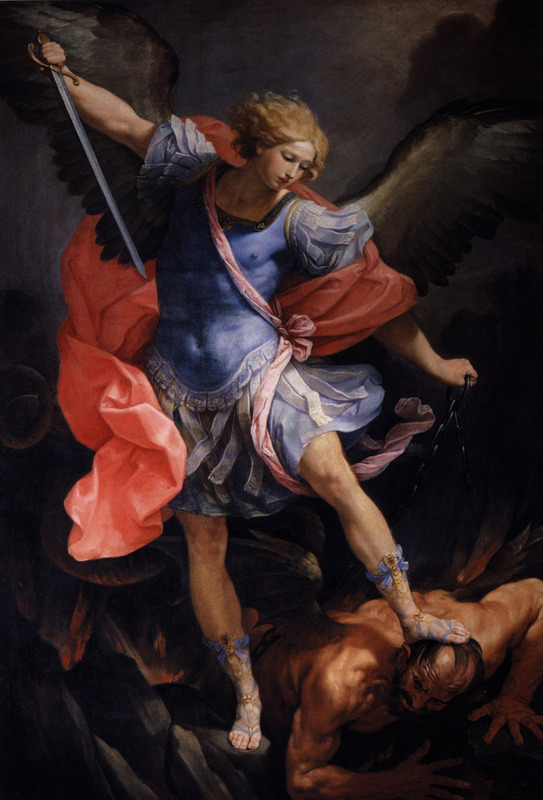How do you see St Michael? One of God’s mighty angels? Or, in the UK, a clothing brand by a large department store? [Marks and Spencer’s St Michael’s range] Or as he is depicted in many paintings and church stain-glass windows, the white superhero spearing the brown devil?
Michael, the archangel, Saint Michael, appears all over the place. He’s not just in the Hebrew and Christian Bible, but also in the Quran and in neo-pagan literature, as well as in countless poems, paintings, statues, music and jewellery. But wherever he appears, he is always strong and invincible.
In the Book of Daniel Michael, the archangel, appears to Daniel and says he is “the protector of Israel” (Daniel 10:13-21) and in Daniel 12:1 saying he will “arise again during the end of time”. In both the Book of Jude (1:9) and in the Book of Revelation (12:7-9), the Archangel Michael is stronger than Satan and defeats and banishes him. In the Quran Sura 2:98 says “Whoever is an enemy to God, and His angels and His messengers, and Jibrail and Mikhail! Then, God (Himself) is an enemy to the disbelievers.” Some Muslims believe that Michael is one of the three angels who visit Abraham (Sura 11:69).
Neo-pagan tradition has leylines, lines of spiritual energy that pass through various points on the land. The most famous one is the St Michael’s leyline; which goes from St Michael’s Mont in Cornwall, through Glastonbury Tor to Bury St Edmunds, Norfolk. There is another St Michael’s leyline from Skelling Michael, Ireland, through St Michael’s Mont, Cornwall to Mount Carmel in Israel.
In Alexander Carmichael’s The Carmina Gadelica, compiled during his travels as in the Scottish Highlands and Islands during the late nineteenth century, 29th September, the Feast of St Michael, was a time for great celebration; with feasting, dancing, visiting the ancestral graves, horse racing, and young people to find a partner. Ray Simpson says in Exploring Celtic Spirituality, every husbandman would give food to the alms-deserving as an offering to “the great God of the elements who gave him cattle and sheep, bread and corn, power and peace, growth and prosperity, that it may be for his abject, contrite soul when it goes thither”. Saint Michael’s feast day was seen as a day of promise to the young and a day of fulfillment for those older, and a day of retrospection to the aged. Carmichael says, “it is a day when pagan cult and Christian doctrine meet and mingle like the lights and shadows on their Highland hills.”
Around the same time Carmichael was gathering his The Carmina Gadelica, the Catholic church in Rome was under persecution from the King of Italy, and the pope wrote this prayer to St Michael.
St Michael’s prayer
“Saint Michael the Archangel, defend us in battle. Be our protection against the wickedness and snares of the devil; May God rebuke him, we humbly pray; And do thou, O Prince of the Heavenly Host, by the power of God, thrust into hell Satan and all evil spirits who wander through the world for the ruin of souls. Amen.”
So again I ask, how do you see St Michael? End time deliverer, patron saint of the harvest, the defeater of the devil, a great redeemer, a connector of power lines through the earth? Which one of these Saint Michaels do you want him to be? Or maybe, in these turbulent times, we need him to be all of these – to help us take joy in what we have reaped and what will fulfill us during these times (harvest), defeater of the devil/our enemies, one who can redeem the earth to its purpose, and able to connect the power of the earth to help redeem us from global warming, pandemics, etc.
These are times of great trial, times when we need to look above and beyond, times when we need all the help God has, but also time to rejoice in the good of what is being harvested. Perhaps we do need to stop and reflect and see this day as a day of promise to the young. A day of fulfillment for those older, and a day of retrospect to the aged. Let us pray the prayer but also rejoice and remember that St Michael, and God, are all these things.
REFERENCES:
“Celtic Christian Spirituality: An Anthology of Medieval and Modern Sources” by Oliver Davies and Fiona Bowie for the quotes from Alexander Carmichael’s The Carmina Gadelica
“Exploring Celtic Spirituality” by Ray Simpson
Photo by Guido Reni – http://www.andrewgrahamdixon.com/archive/readArticle/257, Public Domain, https://commons.wikimedia.org/w/index.php?curid=9571452

